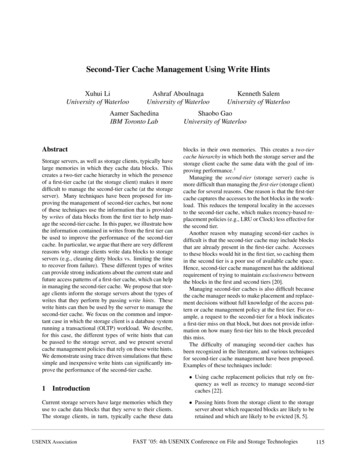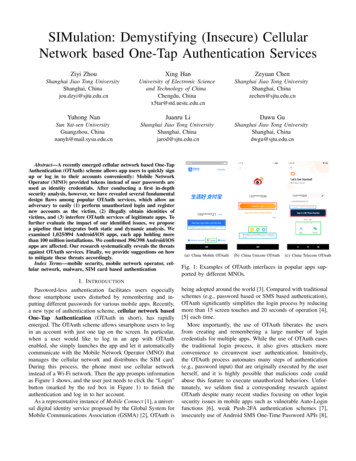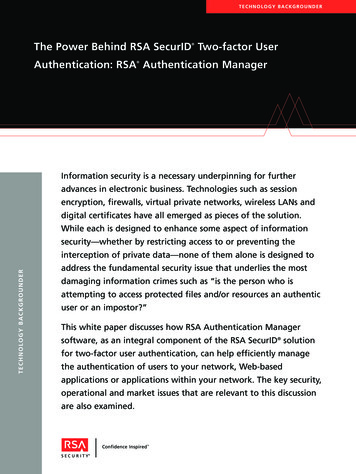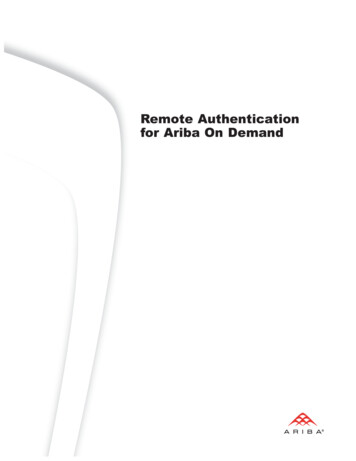
Transcription
BULGARIAN ACADEMY OF SCIENCESCYBERNETICS AND INFORMATION TECHNOLOGIES Volume 21, No 4Sofia 2021Print ISSN: 1311-9702; Online ISSN: 1314-4081DOI: 10.2478/cait-2021-0046A Three-Tier Authentication Scheme for Kerberized HadoopEnvironmentM. Hena, N. JeyanthiSchool of Information Technology and Engineering, VIT Vellore, Tamilnadu, IndiaE-mails: henashabeebvit@gmail.com njeyanthi@vit.ac.inAbstract: Apache Hadoop answers the quest of handling Bigdata for mostorganizations. It offers distributed storage and data analysis via Hadoop DistributedFile System (HDFS) and Map-Reduce frameworks. Hadoop depends on third-partysecurity providers like Kerberos for its security requirements. Kerberos by itselfcomes with many security loopholes like Single point of Failure (SoF), DictionaryAttacks, Time Synchronization and Insider Attacks. This paper suggests a solutionthat aims to eradicate the security issues in the Hadoop Cluster with a focus onDictionary Attacks and Single Point of Failure. The scheme roots on Secure RemotePassword Protocol, Blockchain Technology and Threshold Cryptography. PracticalByzantine Fault Tolerance mechanism (PBFT) is deployed at the blockchain as theconsensus mechanism. The proposed scheme outperforms many of the existingschemes in terms of computational overhead and storage requirements withoutcompromising the security level offered by the system. Riverbed Modeller (AE)Simulation results strengthen the aforesaid claims.Keywords: Apache hadoop, authentication, bigdata, blockchain, Kerberos.1. IntroductionA tremendous increase in the generation of data has been witnessed in recent yearsand this data needs to be processed innovatively and efficiently to get usefulinformation that can lead to strategic business decisions. Big data is the term used toindicate these voluminous, unstructured, heterogeneous data that cannot be storedand processed by traditional computing systems. Apache Hadoop is a big dataplatform based on Java that offers distributed storage and processing termed asHadoop Distributed File System and MapReduce, respectively.The security of Bigdata is a very serious issue to be taken care of to make thebest use of big data analytics benefits. Most of the issues were caused due tounauthorized access and resultant manipulation or retrieval of data. Apache Hadoopcame without any security features in its initial versions as it was designed to work119
in an internal project environment. Most of the recent Hadoop technologies rely onthird-party security systems like Kerberos Protocol for incorporating security into it.The user is issued with Ticket Granting Tickets and Service Tickets to get the sessionkey for its communication with the secured Hadoop Cluster. However, the KerberosProtocol itself has some in-built pitfalls, which include Single Point of Vulnerabilityor Failure (SoV/SoF), Password Guessing or Dictionary Attacks, Insider Attacks andTime Synchronization Problem. Active researches are happening across the globe toenhance the security issues in Kerberos Enabled Hadoop Clusters. For instance,R a h u l and K u m a r [1], put forward an authentication framework that combinescryptographic techniques, hashing and random number generation to get a unique keyfor clients. But this solution made the system slower and adds computationaloverhead.In a Kerberos-enabled Hadoop Cluster, the Key Distribution Center (KDC) is aSingle Point of Failure in the sense that any failure or attack on the KDC affects theentire authentication system. The KDC comprises an Authentication Server (AS), aTicket Granting Server (TGS) and a local database. This paper proposes a three-tierauthentication framework that has its roots in Secure Remote Password Protocol(SRP), One Time Passwords (OTP) and Threshold Cryptosystems. The focus of thiswork is to eradicate Password Guessing Attacks and Single Point of Failure Problemin the Kerberized Hadoop Clusters. For that, the local database at the KDC is replacedwith a Blockchain network for distributed storage. This is tamper-proof storage andcannot be hence compromised. This eradicates the issues that arise when the localstorage at the KDC is compromised. Next, as in Secure Remote Password (SRP)Protocol [2], the password or any details about it are not directly shared with theKDC. Instead, a salted hash of the password along with the user public key is shared.This is verified using the result mined from blockchain storage. Thus, passwordguessing attacks can be avoided and the session key for the user to communicate withthe Ticket Granting Server is securely shared. An enhanced One Time Password isused as proposed by H e n a and J e y a n t h i [3], to verify that the session key iscomputed correctly at both ends, that is, at the user and the AS. The user needs torespond correctly as per the pre-agreement which will be further elaborated in thecoming sections. The threshold cryptography ensures the authentication systemavailability by deploying multiple Ticket Granting Servers. Thus, even if one of theTicket Granting Server is failed or compromised, a prefixed threshold number ofTicket Granting Servers (TGSs) can collaborate and accomplish the authenticationfunction. The proposed system achieves the desired level of security suitable for realtime big data systems with less communication and computational overhead.Moreover, the usage of tamper-proof blockchain technology pushed out storagemanagement from the KDC. Practical Byzantine Fault Tolerance (PBFT) [4]Mechanism is used as the consensus mechanism at the blockchain network. Itdemands more than 2/3 of the total number of nodes need to honest in contributingthe mined result. The nodes in the network are arranged such that each node cancommunicate with each other and there is no permanent leader. The nodes leadershipcomes in turn.120
The remaining of this paper is organized in six sections. Section 2 explains thePreliminaries and Mathematical Intuitions. Section 3 discusses the related works.Section 4 presents the system being proposed. The implementation details and resultanalysis are described in Section 5. Section 6 concludes the paper.2. Preliminaries and mathematical intuitions2.1. Secure remote password protocolSecure Remote Password Protocol (SRP), zero-knowledge proof protocol, in whichthe client/user demonstrates to the server that he/she knows the right password. Thepassword or any other information from which the password can be deducted is notdirectly sent via the network. In other words, the password stays within the clientsystem itself and the server or any other entity has no clue about what it is. Theprotocol is hence resilient to dictionary attacks and doesn’t rely on any trusted thirdparties.To register, the client submits username 𝑢𝑛𝑎𝑚𝑒, a random salt, 𝑠 and saltedhash of client’s password 𝑝, 𝑥 as verifier, and verifier v:(1)𝑣 𝑔𝑥 ,and(2)𝑥 𝐻(𝑠, 𝑝).Here, 𝑔 is a generator of predetermined group Ǥ, which is an additive group with amultiplication operation. This information is stored by the server in its local databasefor future authentication.To authenticate the user, the user chooses a random number 𝑎 as its secret andgenerates the public key as(3)𝐴 𝑔𝑎 .This value along with the username is sent to the server as an authenticationrequest. The server looks up the corresponding verifier and salt values stored againstthe username in its database. Also, it generates its public key as(4)𝐵 𝑣 𝑔𝑏 .where 𝑏 is a random number generated at the server side.Hence, the server’s public key is blinded with 𝑣, a value derived from the user’spassword. A random value 𝑢 is also generated on the server-side. The server sendsthese values, that is, the salt 𝑠, its public key 𝐵 and random 𝑢 to the client. The clientre-computes the value of 𝑥 using hid/her password and salt 𝑠 received from the server.A common secret, 𝑆 is computed at both sides as(𝐵 𝑔 𝑥 )𝑎 𝑢𝑥 at client side,(5)𝑆 {(𝐴 𝑣 𝑢 )𝑏 at server side.Both sides then hash the value of shared secret 𝑆 to obtain the session key 𝐾 as(6)𝐾 𝐻(𝑆).To verify the key, both sides make use of this key to send messages 𝑀1 and 𝑀2 :(7)Client to Server: 𝑀1 𝐻(𝐴, 𝐵, 𝐾),(8)Server to Client: 𝑀2 𝐻(𝐴, 𝑀1 , 𝐾).121
Both sides re-compute the messages received and verify the messages receivedfrom the other end are the same as the computed one. If same, the user isauthenticated.2.2. The e-OTP mechanismThe e-OTP or Enhanced OTP mechanism works as follows.Instead of just entering the OTP received by the user in this mobile number oremail as such, the user should reply with a code as per the pre-agreement. The userand the Authentication Server shares a Pre-Shared Key (PSK) during the registrationprocess. This will be some random number. During authentication process theauthentication server sends an OTP code to the user, which is another randomnumber. User has to respond back with the digits in the PSK located at positionsdenoted by digits in the OTP. That is, for example, assume the digits in the PSK is“81 52 13 74 65 26 37 98 49” and the OTP send by the AS is “2 1 4 7”. The user hasto reply with digits at 2nd, 1st, 4th and 7th positions in the received file. That is,“5 8 7 3” in this case.2.3. Threshold cryptographyThreshold Cryptography is a technique that encrypts the information and splits it intoparts to store in different fault tolerant systems. Asymmetric Cryptosystem is usedhere. The information is encrypted using public key and the private key to decrypt itis distributed among the shareholders. A prefixed threshold number of shareholdersneed to collaborate and contribute their shares to get the decryption key to decryptthe information. If n be the total number of shareholders or participants, and t be thepre-fixed threshold number, then at least t number of participants should contributetheir shares to decrypt the message correctly.3. Related worksMany satisfactory proposals have been put forward by researchers across the globein the field of big data security. L i et al. [5] have proposed DistributedAuthentication and Authorization Scheme (DAAS) to solve the problem ofAuthentication, Authorization and Auditing (AAA) in Bigdata. It also safeguardsBigdata veracity, secure key exchange, and confirmation of user identity. The schemedeploys Identity-based Signature for user authentication and Ciphertext PolicyAttribute-Based Encryption (CP-ABE) for authorization. The problem here CP-ABEis less efficient for its difficulty to manage users and specify policies when the sizeof the universe attribute increases. Moreover, the Identity-based Signature schemehas the inherent problem of key escrow property. W a n g et al. [6] have proposed apre-authentication approach wherein the data at cloud is shared with others with fullknowledge of users. The users who satisfy certain conditions are only given accessto the secured data. However, the method involves complex computations. W a n get al. [6] have proposed a Software-defined architecture to improve the security andperformance of the Industrial Internet of Things (IIoT). However, it’s difficult to122
standardize Software Defined Networking (SDN). Also, centralized control systemleads to delay in data forwarding. To address the issue of latency, A a z a m,Z e a d a l l y and H a r r a s [8] have proposed to deploy Fog Computing between theIoT devices and the cloud. O m o n i w a et al. [9] also have recommended tointroduce Fog computing. But, both the works have given the least priority tosecurity.A One-Time Pad (OTP) based method has been proposed by S o m u, G a n g a aand S r i r a m [10]. The method uses two servers – the registration server and thebackend server. The authors recommend encrypting the user’s password with a OTPand are further secured with modular operations before storing it in the registrationserver. This is again encrypted with the users’ password and stored along withusername in the backend server. During the authentication phase, the user providesonly the username. The backend server sends a key encrypted with the user’spassword and if the user successfully decrypts it user is authenticated. This methodincurs avoidable communication overhead and the method is later proved to bevulnerable to offline password guessing attack as investigated by S a r v a b h a t l a e t,C h a n d r a, and V o r u g u n t i [11]. The authors proposed to hash values ofpasswords and usernames before transmitting over the internet. Though it addssecurity, additional computational and communicational overhead and consequentlatency should be expected. This is not an acceptable feature for a big data platformsecurity system.E s f a h a n i et al. [12] have proposed a lightweight authentication for machineto-machine message exchange in the IoT Environment. The method relies on simpleXOR operations and Hashing. Secure Elements (SE) in the sensor devices andTrusted Platform Modules (TPM) in the network devices like routers are used forauthenticating. The reliability of the Trusted Platform Module in terms of bugs andother online attacks is a concern here. A privacy-preserving authentication protocolbased on biometrics using Elliptic Curve Cryptography (ECC) is proposed by L iet al. [13]. Complex computations at sensor nodes and gateway nodes forauthentication are not an ideal deal as sensors in most cases have less computationalpower. A blockchain-based approach is proposed by L i n et al. [14] using AttributeBased Signature (ABS) and Certificateless Multi-Receivers Encryption (CL-MRE).The performance is not optimized and hence causes considerable degrading of systemperformance. K a r a t i, I s l a m and K a r u p p i a h [15] have proposed a securescheme based on Certificateless Signatures using bilinear pairing. Although theauthors claim the scheme to be computationally efficient, the execution cost standshigh if some pairing computations are not discarded. Z h a n g et al. [16] later haveproved the failure of K a r a t i, I s l a m and K a r u p p i a h [15] scheme against somesignature falsification attacks and proposed a robust Certificateless Signature Schemefor data authentication. The scheme introduces partial private key generation. Theproblem with this scheme is the complex computations involved. A blockchain-basedscheme with a deep reinforcement scheme is proposed by L i u, L i n and W e n [17]and a credit-based consensus mechanism is proposed by H u a n g et al. [18]. Thesemethods have storage overhead and computational complexity. The schemes fail to123
control the quality of collected data as well and hence are not practical in a big datascenario.As per the above study, it is understood that each method has got one or othersetback. Decentralizing the authentication task while guaranteeing the security of theuser and/or data is a challenging chore. The network and processing delay also needto be taken care of.4. Proposed systemThe proposed system has its roots in Secure Remote Password (SRP) Protocol [22],threshold cryptography and blockchain technology. The existing Kerberos enabledHadoop Cluster environment is modified as follows:1. The user demonstrates to the KDC that he knows the password withoutplainly sharing it. A salted hash of it is shared (as exponent of generator of a predetermined cyclic group Ǥ).2. Blockchain network stores user details instead of local storage.3. Single Ticket Granting Server (TGS) at KDC is substituted with many TicketGranting Servers (TGSs) as in [23], wherein a pre-determined threshold number ofTGSs should work together to get the decryption key to decrypt the Ticket GrantingTicket (TGT).The client’s details is kept in the blockchain as quadruplets{ username , verifier , salt , PSK } [where salt is a random number, 𝑥 is saltedhash of the password and verifier 𝑣 is calculated by exponentiation of 𝑔 thegenerator, of the pre-determined Group with 𝑥]. The Client submits a request for aauthentication at the Key Distribution Center (KDC). The Authentication Server (AS)posts the user information to the Blockchain. The miners in the get the userinformation and send corresponding salt and verifier to the AS. The user obtains its𝑠𝑎𝑙𝑡 stored at the KDC during registration (at blockchain) under his username, alongwith the public key of the AS and an unsigned integer 𝑢. Both user and the AScomputes a common secret 𝑆 using their own formula. The session key 𝐾 is computedas hash of the value of 𝑆.To confirm the correctness of the generated session key, the AS in the proposedsystem, a a random key keyRand is sent to the user. The user encrypts the reply withthe computed session key 𝐾. The response is decided as per the pre-agreement. Thesession key K is considered to be vaild if and only if: the user’s reply can be successfully decrypted by the Authentication Server(AS), as only the AS and the user know the key 𝐾 the user responded appropriately as per the pre-agreement; it indicates thatthe client is authenticated as only the client has the Pre-shared key (obtained from ASduring registration) to figure out the e-OTP (enhanced – One Time Password) as perthe pre-agreementAs illustrated in Fig. 1, the scheme consists of three entities:a. The user.b. The KDC with blockchain storage.c. The secured Hadoop Cluster which user wants to access.124
Table 1. Summary of related existing authentication mechanisms in the Big Data EnvironmentSchemeProblem Addressedfrom[5] Single Point of Failure[8][11]Need for middleware in IIoT4.0 environmentPassword Guessing attack[12]Password guessing attack[13]User anonymity[14]Mutual authentication withfine-grained access control[15]Data authentication anduntrustworthiness of thirdparties[16][17]Data authentication in IIoTSecure sharing andexchanging dataSingle Point of Failure andother malicious attacksBigdata storage privacy[18][19][20][21]MethodologyIdentity-based cryptography –signature verificationCiphertext-Policy Attribute-basedencryption (CP-ABE) – forauthorizationIntroduce fog as middleware- Hash values of password andusernames before transmitting overthe internet- OTP- Only hash and XOR operations- Secure Elements (SE)in the sensordevices and Trusted PlatformModules (TPM) in the networkdevices like routers are used forauthenticating- The sensors communicate using thealias identity to preventeavesdropping- Elliptic Curve Cryptography- Biometrics- Blockchain- Attribute signature- Multi-receivers encryption- Message authentication codeCertificateless signature schemeusing bilinear pairingComments- CP-ABE scheme – difficulty inmanaging users and specifyingpolicies, overhead increases withincrease in the size of theuniverse attribute set- IBS is key escrow property-Least priority to securityCommunicational andcomputational overhead- Infrastructural changes need tobe made in the sensor devices forincorporating SEs- Reliability of TPMs to beconsideredComplex computations at sensornodes and gateway nodesPerformance not optimized –degrades system performance- High execution cost- Vulnerable to signaturefalsification attacks- Not robust as secure channelneeded between the third party andDOsPartial private key generation- Complex computations- Deep reinforcement learning- Storage overhead- Blockchain- Computational complexityA credit-based Proof-of-Work (PoW) - Sensor data quality controlconsensus mechanism- Storage limitationsOnly users who satisfy certain- Computational complexityattributes are given access to dataSecurity challenges inSoftware-defined IIoT architecture to - Difficult to standardize SoftwareIndustrial IoT andregulate network resourceDefined Networking (SDN)information-based interaction provisioning and speed up- Centralized control system leadsfor the industrial environments information exchange mechanismsto delay in data forwardingin Industry 4.0by an effortlessly customizablenetworking protocolPassword Guessing attack-Communication of password over - Avoidable communicationthe network is avoided by using OTP overheadbased authentication- Offline Password Guessing- User’s password is encrypted using Attackan OTP and stored in the registrationserver- The backend server further encryptsit with user password and store forfuture authentication purposes125
Fig. 1. Proposed system architectureThe AS grants the Ticket Granting Server Ticket which comprises the sessionkey for the user to communicate with the Ticket Granting Server (TGS). The usersubmits the Service Ticket request by providing the Ticket Granting Ticket (TGT).The shareholders at the TGS pool their resources to get the decryption key to decryptthe Ticket Granting Server Ticket (TGT). TGS then sends the Service Ticket and aSession Key for the user to encrypt its communication with Hadoop Name node andvice-versa. The user places then access to secured Service by providing the ServiceTicket along with a sequence number. The Namenode in the Hadoop Cluster addsone to the sequence number and replies to the user. This is for server’s identityverification.The proposed user authentication framework comprises the following steps:a. User registration,b. User Authentication.4.1. User registration phase To register the user sends her identity IDu , a random salt 𝑠, and a salted hash ofthe password 𝑥 to the KDC where(9)𝑥 𝐻(𝑠, Pw),𝐔𝐬𝐞𝐫 𝐊𝐃𝐂: IDu 𝑠 𝑣 𝑔 𝑥 mod 𝑁. The KDC checks if these user ID details already exist in the blockchainstorage. If no, the KDC sends back a PSK to the user for safe storage𝐊𝐃𝐂 𝐔𝐬𝐞𝐫: PSK. KDC posts this user info (ID, 𝑠, 𝑣 𝑔 𝑥 mod 𝑁, PSK) to the blockchain forfuture authentication purposes by calling the smart contract of the blockchain,𝐊𝐃𝐂 𝐁𝐥𝐨𝐜𝐤𝐜𝐡𝐢𝐚𝐧: IDu 𝑠 𝑣 PSK.Table 2 defines various variables used in the proposed algorithm.126
Table 2. Symbols UsedSymbolDefinitionǤAn additive group with multiplicativeoperationN, ꞡGroup Parameters (Prime & Generatorof group Ǥ)Identity of entity xID𝑥Key Distribution CenterKDCAuthentication ServerASPasswordPwPre-Shared KeyPSKpubPublic key of x𝐾𝑥E()Encryption functionSymbol𝑇𝑥DefinitionTicket to access entity xSHA3()Secure Hash Function𝑠𝑥𝐾𝑥𝑦e OTPKEY RANDpvt𝐾𝑥𝛼, 𝛽Random saltSalted hash of passwordSession Key for x & yEnhanced OTPRandomly Generated KeyPrivate key of xPublic parameters for ElGamalEncryption4.2. Authentication Step The user places an authentication request to the KDC with his IDu and the identityof the Ticket Granting Server (TGS) IDTGS , it wants to get access into, together withhis public keypubpvt(10)𝐾u 𝑔𝐾u ,pvtwhere 𝐾u is the secret key of the user.pub𝐔𝐬𝐞𝐫 𝐊𝐃𝐂: IDu IDTGS 𝐾u . The Authentication Server (AS) publishes this to the Blockchain Network sothat the blockchain miners retrieve the user’s verifier 𝑣 and salt 𝑠 from the BC,pub𝐀𝐒 𝐁𝐥𝐨𝐜𝐤𝐜𝐡𝐚𝐢𝐧: IDu IDTGS 𝐾u ,𝐁𝐥𝐨𝐜𝐤𝐜𝐡𝐚𝐢𝐧 𝐀𝐒: 𝑣 𝑠.pvt If user details already exist, the Authentication Server chooses a random 𝐾ASas the secret key and compute analogous public key masked with the verifier 𝑣 of theuser as per following equation:pvtpub𝐾AS 𝑣 𝑔𝐾AS . A 32-bit value 𝑢 is calculated as follows:pubpub(12)𝑢 𝐻 ( 𝐾u , 𝐾AS ).(11)pub Then, the salt 𝑠, public key 𝐾ASand 𝑢 are shared with the user.pub𝐀𝐒 𝐔𝐬𝐞𝐫: 𝑠 𝐾AS 𝑢. The shared secret is calculated at the user side as follows:(13)pubpvt𝑆 (𝐾AS 𝑔 𝑥 )𝐾u 𝑢𝑥 . At the KDC side, the AS computes the shared secret aspubpvt𝑆 (𝐾u 𝑣 u )𝐾AS . Then, the shared secret 𝑆 are hashed at both sides and get the session key,𝐾ua for use in further communication between the user and the Authentication Serveras(15)𝐾ua 𝐻(𝑆).(14)127
The AS then sends a random key to the user,𝐀𝐒 𝐔𝐬𝐞𝐫: keyRand. The user needs to submit the correct response as per the pre-agreement andrevert to the AS. That is, the user should submit the numerals in the Pre-SharedKey, PSK, that are at places indicated by the numerals in the keyRand. This isconsidered as an enhanced type of OTP (e OTP). This e OTP is encrypted using thesession key 𝐾ua ,𝐔𝐬𝐞𝐫 𝐀𝐒: 𝐸𝐾ua ( e OTP). If the AS is successful decrypting the above message and confirms thecorrectness of e OTP then a Ticket Granting Server Ticket (TGT) is allotted to theuser. The Ticket Granting Ticket (TGT) is then encrypted with Ticket GrantingServer’s (TGS’s) the public key as(16)𝑇t 𝐸𝑘 pub (𝐾tu IDu ).TGS Elliptic Curve ElGamal Encryption is deployed here. That is,(17)Encrypt (𝑇t ) 𝑐1 , 𝑐2 𝛼 𝑘 , 𝑇t . 𝛽 𝑘 ,where 𝑘 ℤ𝑝 is a arbitrarily selected integer by the TGS.𝐀𝐒 𝐔𝐬𝐞𝐫: {𝐸𝐾pub (𝐾tu ) 𝑇t }.u The user places a request to the Ticket Granting Server (TGS ) to access thesecured Hadoop Server Service by presenting the Ticket Granting Server Ticket(TGT),User TGS: IDu 𝑇t IDh . TGS is arranged as several TGSs so that a pre-determined threshold numberof TGSs should collaborate to compute the secret key’s shares to decrypt the TGT:o The TGS has divided it into n shareholders to allow multi-partyauthentication.o A predetermined threshold k number of shares of the secret keycontributed by participant TGS is required here to decrypt the Ticket Granting ServerTicket (TGT). This ensures that the TGS is continuously accessible. The decryptionkey share of i-th shareholder is calculated as:pvt𝑑𝑖 (𝑐1 )𝐾𝑖 .o The decryption key is then calculated using the shares as follows:(19)𝑑 𝑖 𝐼 𝑑𝑖 Λ𝑖 ,where Λ𝑖 is calculated using LaGrange’s Construction Method and 𝐼 is the set ofcontributors. Then, the Ticket Granting Ticket (TGT) is decrypted as(20)𝑇t 𝑐2 𝑑 1 .o The client’s authenticity is verified and the TGS issues the HadoopService Ticket (𝑇h ) to the user.𝐓𝐆𝐒 𝐔𝐬𝐞𝐫: {𝑇h , 𝐸𝑘 pub (𝐾uh )},(18)uwhere(21) 128𝑇h 𝐸𝑘 pub (𝐾uh, IDu ).hWith Service Ticket, user accesses the Hadoop Server as follows:
𝐔𝐬𝐞𝐫 𝐇𝐚𝐝𝐨𝐨𝐩: {IDu 𝑇h 𝐸𝑘uh (seq#)}. Then, the Hadoop server answers, and hence the user can confirm theauthenticity of the Hadoop server as follows:Hadoop User: {𝐸𝑘uh (seq# 1)}.The kerberized Hadoop Server Identity should also be confirmed. As a last stepin the proposed method, the user sends a sequence number encrypted with the sessionkey shared between the client and secured Hadoop Server. So, only the securedHadoop server can decrypt it and it returns a one- added value of the sequence numberencrypted with their session key. This endorses that the user got a response from thesame Hadoop server from which it requested the service and is thus mutuallyauthenticated.4.3. Blockchain-assisted consensus mechanismThe proposed scheme deploys the Practical Byzantine Fault Tolerance (PBFT)Mechanism to reach at an agreement on the data being mined from the blockchainstorage for registration/authentication purposes. When the user places a registrationrequest, the Authentication Server forwards the details to the blockchain as follows:𝐊𝐃𝐂 𝐁𝐥𝐨𝐜𝐤𝐜𝐡𝐢𝐚𝐧: IDu 𝑠 𝑣 PSK.The consensus process occurs as per the following steps:Step 1. Generate. The leader node amongst the endorsement nodes receives theabove transaction when its turn comes, and a candidate block is created to add to theblockchain network.Step 2. Pre-prepare. The leader node then broadcasts the candidate node justcreated to all other endorsement nodes in the network.Step 3. Prepare. The endorsement nodes check whether this block data isalready existing one and hashes the block data otherwise. This is then broadcasted toother endorsement nodes in the network.Step 4. Commit. According to PBFT, every node must receive preparemessages from more than 2/3 of the total number of nodes to reach on a decision(consensus). Upon reaching the consensus, every node broadcasts a commit messageto every other nodes.Step 5. Import. This new block is then added to the chain if consensus isreached and the Authentication server is notified.5. Implementation and result analysisRiverbed Modeler (AE) Simulator [24] is opted here to simulate the Kerberos enabledHadoop Environment. As depicted in Fig. 2, it consists of the User Workstations, theKey Distribution Center (KDC) with an Authentication Server (ASr), and numerousTicket Granting Servers (TGSs) and secured Hadoop Cluster with Namenode andDatanodes. The ppp wkstn adv node object is deployed as a user workstation and isaccepted as the originator of all the communications. ppp server adv node object isdeployed as the Authentication Server, Ticket Granting Server and as Namenode.The Internet node discards 0.0% of inward traffic and augments 100 ms delay to the129
network packets. The authentication request size is presumed to be 2 KB and the userdevotes 4 s to prepare this message. The Blockchain network required 0.5 s to retrievethe user’s salt and verifier. Next phases, namely SRP Verification and PSKvalidation, together needs 4.5 s. The tickets in this model are presumed to be of size1 KB and the ticket encryption takes 5 s. The size of encrypted exchanges betweenthe user and the Hadoop Server is homogeneously distributed between 1 KB and10 KB.5.1. Security analysisThe proposed approach has dealt with most of the security challenges faced byKerberized Hadoop Clusters. The following are the details.5.1.1. Password guessing attacksAssumption 1. An intruder guesstimates the password of a genuine user, he used tolog into the secured system during previous communications.P r o o f: A zero-knowledge-proof security is guaranteed in the proposed schemeas password or any information about it isn’t openly shared with the KDC duringregistration or authentication processes. Adversary 𝒜 won’t thus get any chance toguesstimate the password and enter them into the system. Again, the session key iscomputed from a common shared secret at the user (13) and server (14) sidesseparately.Fig. 2. Simulation environmentThe passwords are stored in a manner that is not directly usable to an attacker.Even if the password database is hacked, the adversary still needed an expensivedictionary search to get the correct password. The computations which involvesexponentiation operations to validate the guess are further time-consuming and130
difficult to solve. The SRP protocol mentions the
A Three-Tier Authentication Scheme for Kerberized Hadoop Environment M. Hena, N. Jeyanthi School of Information Technology and Engineering, VIT Vellore, Tamilnadu, India E-mails: henashabeebvit@gmail.com njeyanthi@vit.ac.in Abstract: Apache Hadoop answers the quest of handling Bigdata for most organizations.










